

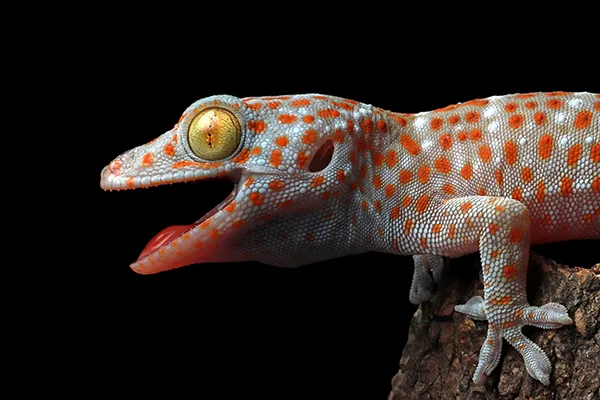
Gordon Burghardt Weighs in on Reptile Moods
Long dismissed as unintelligent, reptiles are emerging as cognitively and emotionally complex animals. A new study involving tortoises suggests that they also possess mood states.
Crowded Conditions Muddle Frogs’ Mating Choices
Female treefrogs prefer a mate with an impressive call, but the crowded environments give unattractive males an edge, according to a new international study led by Assistant Professor Jessie Tanner of the University of Tennessee, Knoxville.
Claire Hemingway and Jessie Tanner published in the journal Trends in Cognitive Sciences
Humans can have a lot to consider when working out the best choices for their needs: buying a car, choosing a home, or just shopping for groceries. An overwhelming number of options can give a person pause. Animals experience this same phenomenon in their decision making: choice overload.
Planning for spring’s garden? Bees like variety and don’t care about your neighbors’ yards
Planning for spring’s garden? Bees like variety and don’t care about your neighbors’ yards
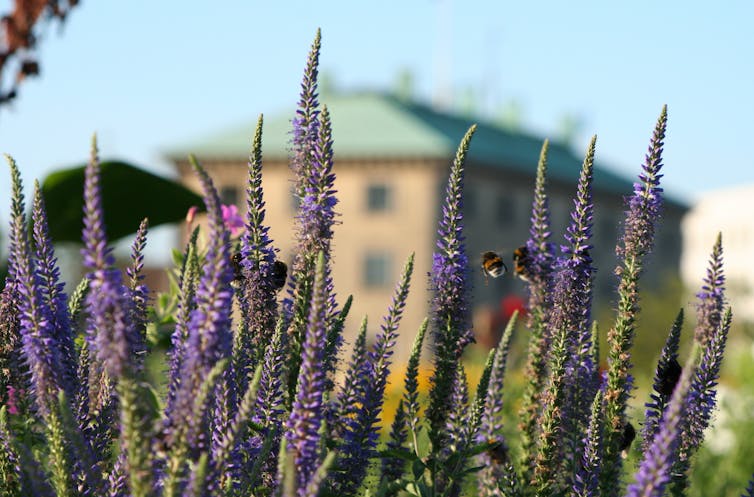
In order to reproduce, most flowering plants rely on animals to move their pollen. In turn, pollinators rely on flowers for food, including both nectar and pollen. If you’re a gardener, you might want to support this partnership by planting flowers. But if you live in an area without a lot of green space, you might wonder whether it’s worth the effort.
I study bees and other pollinators. My new research shows that bees, in particular, don’t really care about the landscape surrounding flower gardens. They seem to zero in on the particular types of flowers they like, no matter what else is around.
To design a garden that supports the greatest number and diversity of pollinators, don’t worry about what your neighbors are doing or not doing. Just focus on planting different kinds of flowers – and lots of them.
Comparing different landscapes
To test whether bees are more plentiful in natural areas, my team and I planted identical gardens – roughly 10 feet by 6½ feet (3 x 2 meters) – in five different landscapes around eastern Tennessee that ranged from cattle pastures and organic farms to a botanical garden and an arboretum. All five gardens were planted in March of 2019 and contained 18 species of native perennials from the mint, sunflower and pea families.
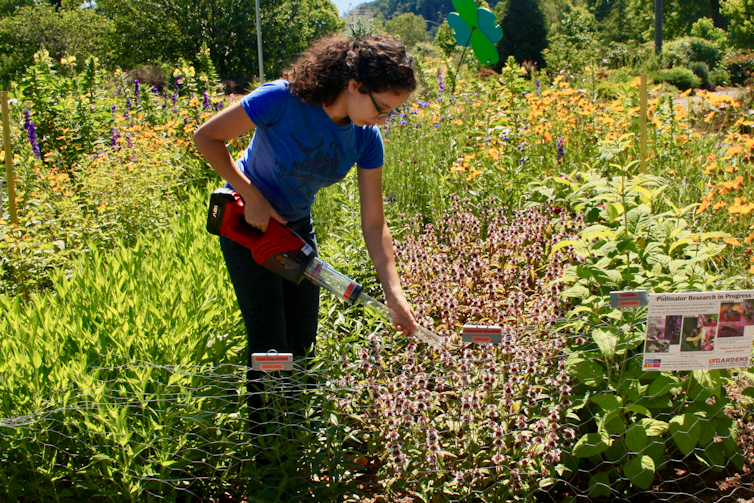
Over the course of the flowering season, we surveyed pollinators by collecting the insects that landed on the flowers, so we could count and identify them. The sampling took place in a carefully standardized way. Each week we sampled every flowering plant in every garden, in every landscape, for five minutes each. We used a modified, hand-held vacuum we called the “Bug Vac” and repeated this sampling every week that flowers were in bloom for three years.
We wanted to test whether the area immediately surrounding the gardens – the floral neighborhood – made a difference in pollinator abundance, diversity and identity. So we also surveyed the area around the gardens, in a radius of about 160 feet (roughly 50 meters).
To our surprise, we found the surrounding terrain had very little influence on the abundance, diversity and composition of the pollinators coming to our test gardens. Instead, they were mostly determined by the number and type of flowers. Otherwise, pollinators were remarkably similar at all sites. A sunflower in a cattle pasture had, by and large, the same number and types of visitors as a sunflower in a botanical garden.
Menu planning for pollinators
We used native perennial plants in our study because there’s evidence they provide the best nutrition for flower-visiting insects. We chose from three plant families because each offers different nourishment.
Plants in the mint family (Lamiaceae), for example, provide a lot of sugary nectar and have easily accessible flowers that attract a wide variety of insects. I’d recommend including plants from the mint family if you want to provide a large and diverse group of insects energy for flight. If you live in Tennessee, some examples are mountain mint, wood mint and Cumberland rosemary. You can easily search for perennial plants native to your area.

While some pollinators enjoy nectar, others get all their fat and protein from eating just the pollen itself. Flowers from the sunflower family (Asteraceae), including asters and coreopsis, offer large quantities of both pollen and nectar and also have very accessible flowers. Plants from this family are good for a range of pollinators, including many specialist bees, such as the blue-eyed, long-horned bee (Melissodes denticulatus), which feasts primarily on ironweed (Vernonia fasciculata), also a member of the sunflower family.
If you want to offer flowers that have the highest protein content to nourish the next generation of strong pollinators, consider plants from the pea family (Fabaceae), such as dwarf indigo, false indigo and bush clover. Some of the plants in this family do not even offer nectar as a reward. Instead, they provide high protein pollen that’s accessible only to the most effective pollinators. If you include plants from the pea family in your garden, you may observe fewer visitors, but they will be receiving pollen with high protein levels.
Selecting a few native perennials from each of these three families, all widely available in garden centers, is a good place to start. Just as a diversity of food is important for human health, a mixture of flower types offers pollinators a varied and healthy diet. Interestingly, the diversity of human diets is directly linked to pollinators, because most of the color and variety in human diets comes from plants pollinated by insects.
Plant it and they will come
Maybe you’ve heard that insects worldwide are declining in number and variety. This issue is of particular concern for humans, who rely on insects and other animals to pollinate food crops. Pollinators are indeed facing many threats, from habitat loss to pesticide exposure.
Thankfully, gardeners can provide an incredible service to these valuable animals just by planting more flowers. As our research shows, small patches of garden can help boost pollinators – even when the surrounding landscape has few resources for them. The one constant in all our research is that insects love flowers. The more flowers and the more types of flowers, the more pollinators Earth will have.
Laura Russo, Assistant Professor of Ecology and Evolutionary Biology, University of Tennessee
This article is republished from The Conversation under a Creative Commons license. Read the original article.
The Conversation: Vampire Bats – Look Beyond the Fangs and Blood To See Animal Friendships and Unique Adaptations
Vampire bats – look beyond the fangs and blood to see animal friendships and unique adaptations

You can probably picture a vampire: Pale, sharply fanged undead sucker of blood, deterred only by sunlight, religious paraphernalia and garlic. They’re gnarly creatures, often favorite subjects for movies or books. Luckily, they’re only imaginary … or are they?
There are real vampires in the world of bats. Out of over 1,400 currently described bat species, three are known to feed on blood exclusively.
The common vampire bat, Desmodus rotundus, is the most abundant. At home in the tropical forests of Central and South America, these bats feed on various animals, including tapirs, mountain lions, penguins and, most often nowadays, livestock.
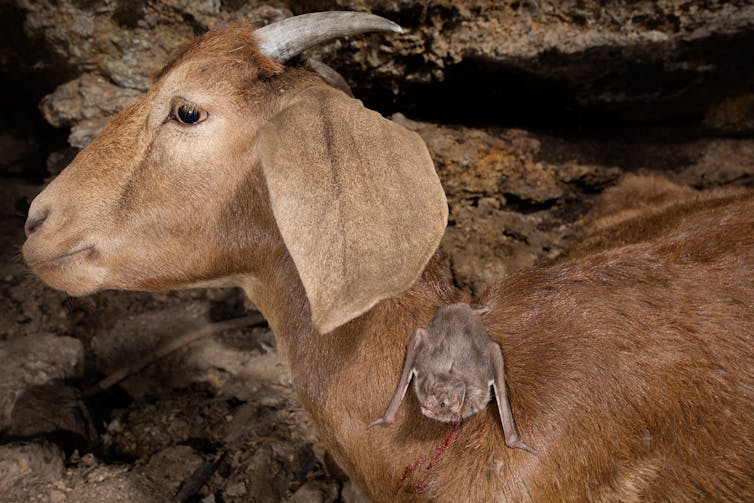
Feeding on a blood diet is unusual for a mammal and has led to many unique adaptations that facilitate their uncommon lifestyle. Unlike other bats, vampires are mobile on the ground, toggling between two distinct gaits to circle their sleeping prey. Heat-sensing receptors on their noses help them find warm blood under their prey’s skin. Finally, the combination of a small incision, made by potentially self-sharpening fangs, and an anticoagulant in their saliva allows these bats to feed on unsuspecting prey.
To me, as a behavioral ecologist, who is interested in how pathogens affect social behaviors and vice versa, the most fascinating adaptations to a blood-feeding lifestyle are observable in vampire bats’ social lives.
Vampire bats build reciprocal relationships
Blood is not very nutritious, and vampire bats that fail to feed will starve relatively quickly. If a bat returns to the roost hungry, others may regurgitate a blood meal to get them through the night.
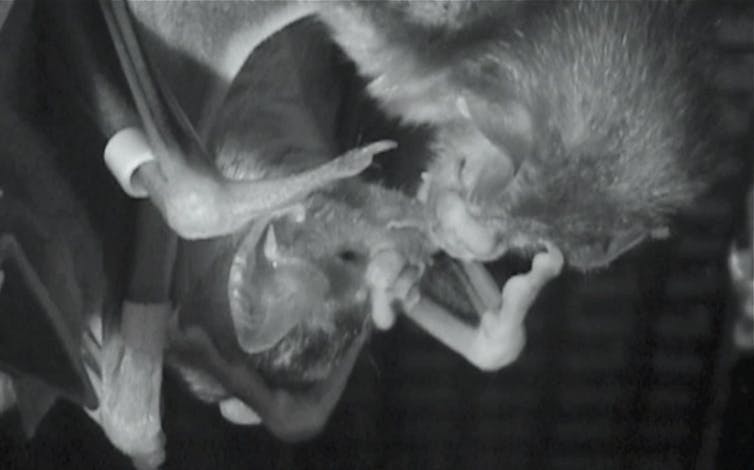
Such food sharing happens between bats who are related – such as mothers and their offspring – but also unrelated individuals. This observation has puzzled evolutionary biologists for quite a while. Why help someone who is not closely related to you?
It turns out that vampire bats keep track of who feeds them and reciprocate – or not, if the other bat has not been helpful in the past. In doing so, they form complex social relationships maintained by low-cost social investments, such as cleaning and maintaining the fur of another animal, called allogrooming, and higher-cost social investments, such as sharing food.
These relationships are on par with what you would see in primates, and some people compare them to human friendships. Indeed, there are some parallels.
For instance, humans will raise the stakes when forming new relationships with others. You start with social investments that don’t cost much – think sharing some of your lunch – and wait for the other person’s response. If they don’t reciprocate, the relationship may be doomed. But if the other person does reciprocate by sharing a bit of their dessert, for instance, your next investment might be larger. You gradually increase the stakes in a game of back-and-forth until the friendship eventually warrants larger social investments like going out of your way to give them a ride to work when their car breaks down.
Vampire bats do the same. When strangers are introduced, they will start with small fur-cleaning interactions to test the waters. If both partners keep reciprocating and raising the stakes, the relationship will eventually escalate to food sharing, which is a bigger commitment.
Relationships, in sickness and in health
My lab studies how infections affect social behaviors and relationships. Given their vast array of social behaviors and the complexity of their social relationships, vampire bats are the ideal study system for me and my colleagues.
How does being ill affect how vampire bats behave? How do other bats behave toward one that is sick? How does sickness affect the formation and maintenance of their social relationships?
We simulate infections in bats in our lab by using molecules derived from pathogens to stimulate an immune response. We’ve repeatedly found a form of passive social distancing where sick individuals reduce their interaction with others, whether it’s allogrooming, social calling or just spending time near others.
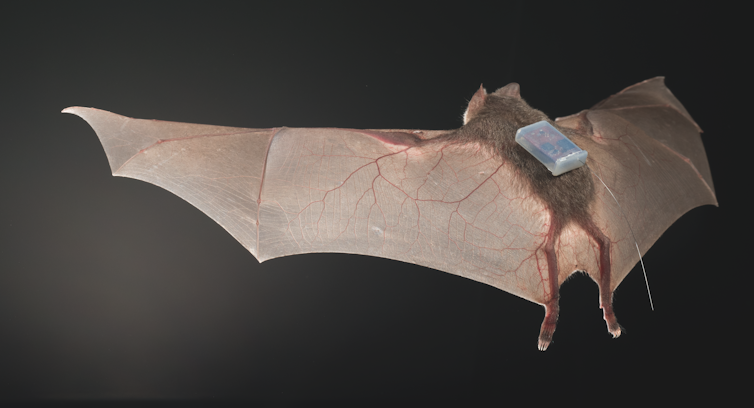
Importantly, these behavioral changes haven’t necessarily evolved to minimize spreading disease to others. Rather, they are parts of the complex immune response that biologists call sickness behaviors. It’s comparable to someone infected with the flu staying at home simply because they don’t feel up to venturing out. Even if such passive social distancing may have not evolved to prevent transmission to others, simply being too sick to interact with others will still reduce the spread of germs.
Interestingly, sickness behaviors can be suppressed. People do this all the time. So-called presenteeism is showing up at work despite illness due to various pressures. Similarly, many people have suppressed symptoms of an infection to engage in some sort of social obligation. If you have little kids, you know that when everyone in your household is coming down with something, there’s no way you can just sit back and not take care of the little ones, even if you feel quite bad yourself.
Animals are no different. They can suppress sickness behaviors when competing needs arise, such as caring for young or defending territory. Despite their tendency to reduce social interactions with others when sick, in vampire bats, sick mothers will continue to groom their offspring and vice versa, probably because mother-daughter relationships are extra important. Mothers and daughters are often each other’s primary social relationships within groups of vampire bats.
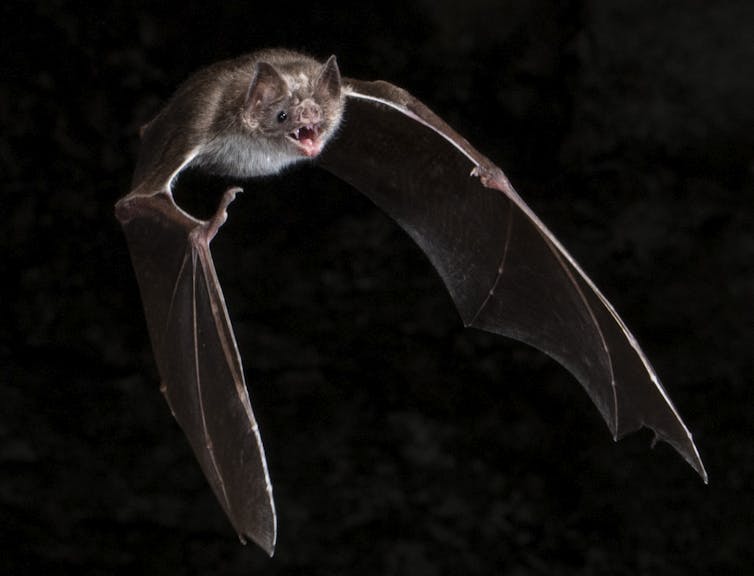
Human-bat conflict centers on livestock
Despite their many fascinating adaptations and complex social lives, vampire bats are not universally admired. In fact, in many areas in South and Central America, they are considered pests because they can transmit the deadly rabies virus to livestock, which can cause quite significant economic losses.
Before people introduced livestock into their habitat, vampire bats probably had a harder time finding food in the form of native prey species such as tapirs. Now, livestock has become their primary food source. After all, why not feed on something that is reliably at the same place every night and quite abundant? Increases in livestock abundance come with increases in vampire bat populations, probably perpetuating the problem of rabies transmission.
The farmers’ quarrels with vampires make sense, especially in smaller cattle herds, where losing even one cow can significantly hurt a farmer’s livelihood. Culling campaigns have used topically applied poisons called vampiricide, basically a mix of petroleum jelly and rat poison. Bats are caught, the paste is applied to the fur, and they carry it back to the roost, where others ingest the poison during social interactions. Interestingly, large-scale culling may not be very effective in reducing rabies spillover.

Now, the focus has started to shift toward large-scale cattle vaccinations or vaccinating the vampire bats themselves. Researchers are even considering transmissible vaccines: They could genetically modify herpes viruses, which are quite common in vampire bats, to carry rabies genes and vaccinate large swaths of vampire bat populations.
Whichever method is used to mitigate vampire bat-human conflicts, more empathy for these misunderstood animals could only help. After all, if you stick your head into a hollow tree full of vampire bats – assuming you can brave the smell of digested blood – remember: You’re looking at a complex network of individual friendships between animals that care deeply for each other.
Sebastian Stockmaier, Assistant Professor of Ecology and Evolutionary Biology, University of Tennessee
This article is republished from The Conversation under a Creative Commons license. Read the original article.
New UT Center Combines Disciplines to Study Animal Behavior
The Collaborative for Animal Behavior (CoLAB) is a pioneering research center dedicated to understanding the complexities of animal behavior in a rapidly changing world. This new center within the UT College of Arts and Sciences brings together scholars from diverse fields to collaborate on research programs that address critical challenges at the intersection of animal behavior, environmental change, and human influence.
Adams Expands Research Flock with Latvian Fulbright Experience
Colton Adams, a 2023 graduate in honors ecology and evolutionary biology, continued his academic journey as one of UT’s 13 Fulbright Scholars for 2023–2024, contributing to the Big Orange reputation as a top producer of these accomplished students.
Adams traveled to the University of Latvia, in the city of Riga, to collaborate with the zoology and animal ecology group there, investigating questions about behavioral ecology and acoustic communication in mixed-species flocks of birds. He found himself immediately taken with the Eastern European landscape.
Burghardt honored by Animal Behavior Society
Animal behavior captivated Gordon Burghardt as a boy, and over more than half a century at the University of Tennessee, Knoxville, his interdisciplinary research advanced ethology in areas including animal play, social behavior, communication, reptile behavior, enrichment, and animal cognitive abilities.
The Animal Behavior Society (ABS) recognized his outstanding lifetime achievement by awarding Burghardt the 2024 Distinguished Animal Behaviorist Award during its annual meeting in late June.
Fruit flies may enjoy taking carousels for a spin
EEB Alumni Distinguished Service professor Dr. Gordon Burghardt comments on the first documented example of locomotor play in an invertebrate. Read the article here: https://www.science.org/content/article/fruit-flies-may-enjoy-taking-carousels-spin